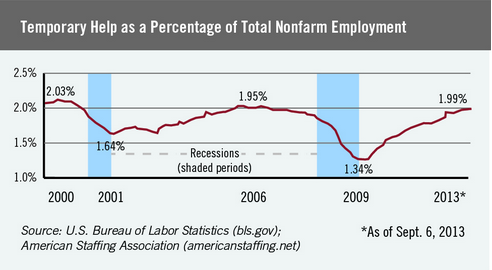In the last four years, temporary work has grown at three times the pace of permanent work in North America.
In 2012, there were 2 million temporary workers in Canada or, 13.6% of the workforce. As well, the last quarter of the year saw the demand for temporary workers grow by 15% compared to this time last year (1). The same trends were observed in the USA. In August 2012, there were 2.5 million contract and temporary workers in the USA, and between 2009 and 2012, the number of temporary employees rose by 29% (2). According to the Bureau of Labor Statistics, temporary employment was up 8.1% year-over-year in 2014.
Temporary work is becoming popular across a diverse range of fields and levels of expertise. Upward trends in temporary workforce employment have been observed in the education, culture, and accommodation and food services industries (3), as well as in the nursing, information systems, and financial services industries (4).

Across all industries, employers are seeking flexible work solutions to manage productivity and increase competitiveness.
Why are companies so inclined to utilize contingent staffing solutions?
-
Cost Advantage
In working with staffing agencies, the agency, not the employer, becomes the employer of record, responsible for the worker’s administration costs. Since the cost of hiring temporary workers (in the short term) is often less expensive than the cost of recruiting and retaining permanent employees, employers can increase capacity and maintain productivity while benefiting from cost savings.
-
Flexibility and Increased Capability
A temporary workforce enables employers to be flexible – expanding or contracting their workforce’s skill set to reflect their evolving needs. While traditionally temporary workers had been employed to fill roles of lower skill, today, temporary workers are often hired to complete critical projects in highly specialized roles. By using flexible temporary work solutions, employers can effectively grow their business – boosting productivity and increasing their bottom line.
-
Cyclicality and Increased Capacity
By hiring temporary workers, employers can better plan for seasonality and workforce changes. For example, with summer months bringing an increase in employee vacation coverages and an upswing in the hospitality, tourism and service industries, employers are leaning on the temporary workforce to support seasonal fluxes in staffing requirements.
With these advantages in mind, it’s no surprise that more than 40% of employers plan to hire temporary and contract workers this year(5).
In the years following the recession, temporary staffing has quickly become the go-to solution for many employers striving to improve their flexibility, competitiveness, and bottom line. Given the nature of temporary labor, concern has been expressed in both the United States and Canada about employees not being compensated well or being entitled to benefits. TPD was founded with the goal to eliminate this form of two-tiered workforce, and offers premium benefits packages to temporary staff. In this way, not only are employees compensated fairly and more engaged in their work, but employers also benefit from access to high quality, retained employees.
Learn more about TPD Staffing through one of our success stories!
Sources:
-
1 - Statistics Canada
-
2 – Labor Bureau
-
3 – The Globe and Mail
-
4 – CareerBuilder
-
5 – CareerBuilder
Filed under HR Trends

.png?width=2400&name=HQ%20TPD%20careers%20hero%20(1).png)





